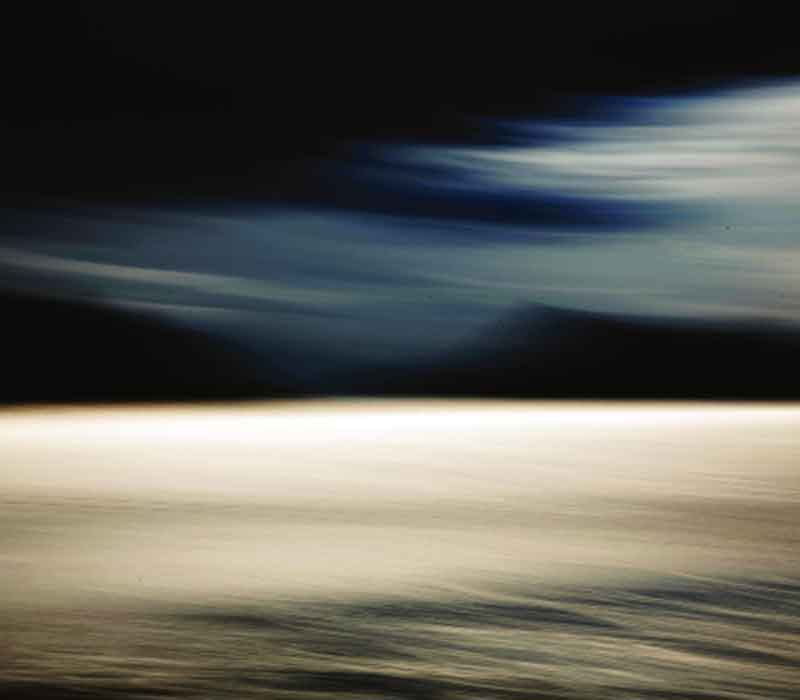Artist Prabir Purkayastha creates symphony of time through Dheemahi, his series of photographs of disappearing landscapes. By U Nair
Artist Prabir Purkayastha has over the past two decades captured dulcet landscapes in Ladakh as well as different parts of the world as an itinerant traveller.
The India Habitat Centre brings back its Photosphere at the Visual Arts Gallery where Prabir’s Dheemahi is an invitation and an invocation to the realm of silent contemplation in a world crazed by technology and conspicuous medleys of materialism.
“My images for Dheemahi are conceptual visual narratives of the disappearing landscapes around us and within us,” states the photographer.
“I don’t want the viewer to be further inundated with images of gruesome reality of the violation of Earth,” adds Prabir and believes that there are far better photographers than him who excel in being masters of doom and gloom.
He says, “I prefer to celebrate the darkness within the darkness.”
One glance at these landscapes invites us into the crevices and shadows of the abyss of pathos and darkened interiors. These are by no means beautiful but they are powerful in the synergy that they present.
“The shadow of grief in our loss is inescapable, something precious is passing us by... a dreamlike state exists in our experiencing what we once loved and are now sadly loosing. It is as if we are witnessing the passing of life itself,” explains Prabir.
He explains the electrifying speed that soars across the frame and elucidates that the images are in motion and translucent. The darkness is prevalent and brooding, but the mystical light is always present and gives hope of a better day to come.
Prabir recalls the Vedas, probably the oldest holy scriptures known to man, which seeded the thought of holistic sustainability over 5,000 years ago. “Bhuh Bhuvah Svah... These three words of the Gayatri mantra, in the Rig Veda, which mean earth, air and cosmos give us the knowledge of the entire cosmos. And this mystical knowledge, born of man's umbilical connection to Bhumi, is the guiding light that gently steers us through the dark labyrinths of time,” explains Prabir.
According to him, in today's world, we have with alarming apathy and contemptuous attitude turned our backs to this guiding ‘light’, and subsequently to the planet we live upon.
For this, we raise a cacophony of futile excuses and explanations in today’s Kali Yug. But primarily it is man’s unparalleled ruthlessness and inexplicable thoughtlessness that is strangling his very own ‘raison d'etre,’ or so Prabir believes.
He provokes the viewer into a meandering medley of thoughts with integral and imperative questions, “As we hurtle ourselves into oblivion, is there no power to steer us away from the pending Pralay? Are we, as a race, beyond all hope and redemption?”
The photographer believes that in this frightfully unsettling narrative and brutal spectacle lives a potent cosmic force, a benevolent energy that man can merge into for his future existence.
Dheemahi — ‘we contemplate’ — presents a traditional visual narrative about our hidden world, a visual tapestry that amplifies the disappearing desolation, around and within us. The resulting effect of such sublime contemplation in the exhibition will make it impossible to ignore the Earth that we are destroying. And, one that we need to passionately nurture and celebrate. For ourselves and for the future generation as well.
The explanation that Prabir extols presents another realm that we must meditate upon. “The divine dhiksha, of simple contemplation for our Bhumi, will seamlessly connect us to one another. And, more importantly, provide us with an immersive and collective conscience to protect and nurture our one and only planet.”
These are landscapes that talk to us about living. Explanations for obscurity come in a rush all day long. A landscape must make us ponder. It must make us think of what we have not seen and felt. Most landscapes are predictable and passive, but here are a set that are ephemeral by definition, telling us that they are quick to decay but at the same time they stand testimony to the beauty of a painting, a symphony or a novel.
It explores a mapping of understanding that “Landscapes are for living,” and also become a vehicle for and expression of a certain inchoate impulse.


























